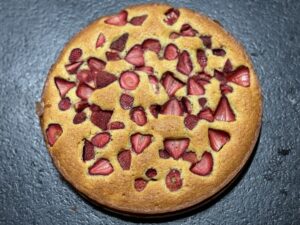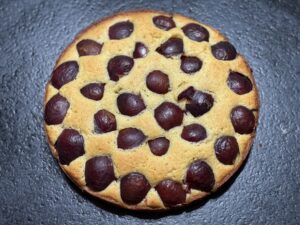

If you cue up the internet search engine of your choice and type “Marian B”, the autofill will complete your query: “Marian Burros’ Plum Torte Recipe.” Suffice it to say I am not the first person to write about this spellbinding dessert, which seems to have more fans than the Boston Red Sox. The recipe was first published by the New York Times in 1983, and re-published by the paper every fall for the next dozen years.
The recipe calls for Italian prune plums. Also known as purple plums, these small, tart fruits don’t often make it to supermarket shelves. So it has always been a mystery to me that the torte could be so popular when its key ingredient is so niche and hard to find for most readers. Because the recipe is completely intolerant of any other type of plum.
I once attempted to make the torte with the incorrect type of plum, thinking I could somehow defy a physical law of the universe that dictates otherwise. Instead of purple Italian plums I used the kind of big, sweet and watery round plums that one typically finds at the grocery store. Typical plums, in other words, rather than prune plums, which are firmer-fleshed and have lower moisture content. My wrong-plum experiment was a failure. It was decidedly inferior to a year old torte that had been made correctly and frozen, which says as much about the torte’s storability as its insistence on only this type of plum.
But in a major shake-up of the Marian B plum torte universe, I have recently discovered that it can also be made with strawberries. This makes the torte accessible to the masses, rather than the few of us lucky enough to inhabit some charming small town with an abundance of backyard plums. Not only that, but a majority of testers, including both of my kids, actually prefer the strawberry version. I write this in a hushed voice, out of respect for the shockwaves it might create. But it needs to be said.
This revelation happened at a food festival in Whitefish, Montana, where there was a pizza stand serving elk sausage pizza. There was a strawberry torte in the pastry case, and I ordered a slice. At this point I was unsuspecting, but when I bit into the torte I immediately recognized it as the one true torte, only made with strawberries rather than purple plums. And the strawberry rendition was absolutely amazing. Every bit as impressive and perfect as the purple prune plum rendition. In fact my kids even prefer it to the original.
Given how popular this recipe became, even when its made with an ingredient that most American’s could never find, the news that it can be made with strawberries is a game changer. Nobody has any excuses. Everyone should have lots of torte.
Marian Burros’ Original Plum Torte
It must be made with either Purple Italian Prune Plums or strawberries. No substitutions, as these are the only known fruits with the correct balance of sweet, tart and moisture content.
Being a torte, there is no crust to worry about. The batter has enough butter that it wouldn’t dream of sticking to the pan, and when sliced it holds together just fine. So the crust will not be missed.
The quantities listed are for one 9-inch torte. You will need a 9-inch springform pan to make it.
Ingredients
1 cup all-purpose flour, sifted
1 teaspoon baking powder
Pinch of salt
1 stick butter, room temperature soft
3/4 cup sugar
2 eggs
12 purple Italian prune plums, pitted or split in half; or two pints of strawberries, sliced in half.
2 teaspoons sugar + 1 teaspoon cinnamon to sprinkle on top
Procedure
Pre-heat oven to 350.
Combine the flour, baking soda and salt in a medium bowl.
Cream the sugar and butter in a cake mixer. Add the eggs, followed by the dry ingredients. Mix until fully combined.
Spread the batter into a 9-inch springform pan. Arrange the plums atop the batter in concentric circles, skin side up. Or if using strawberries, arrange them cut sides down on the batter.
Sprinkle the top of the torte with the extra sugar and the cinnamon.
Bake the torte for 40 minutes. If it starts to brown before that time has passed, test the batter with a toothpick. If it comes out clean, the torte is done.
Allow to cool for 20 minutes and enjoy. If you wish to freeze it, let it cool overnight, wrap in foil, and seal the foiled torte in a plastic bag.